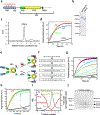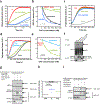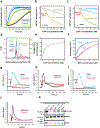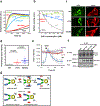A complex containing lysine-acetylated actin inhibits the formin INF2
- PMID: 30962575
- PMCID: PMC6501848
- DOI: 10.1038/s41556-019-0307-4
A complex containing lysine-acetylated actin inhibits the formin INF2
Abstract
Inverted formin 2 (INF2) is a member of the formin family of actin assembly factors. Dominant missense mutations in INF2 are linked to two diseases: focal segmental glomerulosclerosis, a kidney disease, and Charcot-Marie-Tooth disease, a neuropathy. All of the disease mutations map to the autoinhibitory diaphanous inhibitory domain. Interestingly, purified INF2 is not autoinhibited, suggesting the existence of other cellular inhibitors. Here, we purified an INF2 inhibitor from mouse brain tissue, and identified it as a complex of lysine-acetylated actin (KAc-actin) and cyclase-associated protein (CAP). Inhibition of INF2 by CAP-KAc-actin is dependent on the INF2 diaphanous inhibitory domain (DID). Treatment of CAP-KAc-actin-inhibited INF2 with histone deacetylase 6 releases INF2 inhibition, whereas inhibitors of histone deacetylase 6 block the activation of cellular INF2. Disease-associated INF2 mutants are poorly inhibited by CAP-KAc-actin, suggesting that focal segmental glomerulosclerosis and Charcot-Marie-Tooth disease result from reduced CAP-KAc-actin binding. These findings reveal a role for KAc-actin in the regulation of an actin assembly factor by a mechanism that we call facilitated autoinhibition.
Conflict of interest statement
COMPETING INTERESTS STATEMENT
The authors declare that they have no financial and non-financial competing interests.
Figures






Comment in
-
Actin: Post-translational Modification of Actin Linked to Formin Inhibition.Curr Biol. 2019 May 20;29(10):R367-R370. doi: 10.1016/j.cub.2019.03.061. Curr Biol. 2019. PMID: 31112687
Similar articles
-
Regulation of formin INF2 and its alteration in INF2-linked inherited disorders.Cell Mol Life Sci. 2024 Nov 25;81(1):463. doi: 10.1007/s00018-024-05499-3. Cell Mol Life Sci. 2024. PMID: 39586895 Free PMC article. Review.
-
Regulation of INF2-mediated actin polymerization through site-specific lysine acetylation of actin itself.Proc Natl Acad Sci U S A. 2020 Jan 7;117(1):439-447. doi: 10.1073/pnas.1914072117. Epub 2019 Dec 23. Proc Natl Acad Sci U S A. 2020. PMID: 31871199 Free PMC article.
-
Novel INF2 mutation p. L77P in a family with glomerulopathy and Charcot-Marie-Tooth neuropathy.Pediatr Nephrol. 2013 Feb;28(2):339-43. doi: 10.1007/s00467-012-2299-1. Epub 2012 Sep 11. Pediatr Nephrol. 2013. PMID: 22961558
-
Mutations to the formin homology 2 domain of INF2 protein have unexpected effects on actin polymerization and severing.J Biol Chem. 2012 Oct 5;287(41):34234-45. doi: 10.1074/jbc.M112.365122. Epub 2012 Aug 9. J Biol Chem. 2012. PMID: 22879592 Free PMC article.
-
Role of formin INF2 in human diseases.Mol Biol Rep. 2022 Jan;49(1):735-746. doi: 10.1007/s11033-021-06869-x. Epub 2021 Oct 26. Mol Biol Rep. 2022. PMID: 34698992 Review.
Cited by
-
Cyclase-associated protein 2 (CAP2) controls MRTF-A localization and SRF activity in mouse embryonic fibroblasts.Sci Rep. 2021 Feb 26;11(1):4789. doi: 10.1038/s41598-021-84213-w. Sci Rep. 2021. PMID: 33637797 Free PMC article.
-
Formins in Human Disease.Cells. 2021 Sep 27;10(10):2554. doi: 10.3390/cells10102554. Cells. 2021. PMID: 34685534 Free PMC article. Review.
-
INF2 formin variants linked to human inherited kidney disease reprogram the transcriptome, causing mitotic chaos and cell death.Cell Mol Life Sci. 2024 Jun 25;81(1):279. doi: 10.1007/s00018-024-05323-y. Cell Mol Life Sci. 2024. PMID: 38916773 Free PMC article.
-
Lysine acetylation of cytoskeletal proteins: Emergence of an actin code.J Cell Biol. 2020 Dec 7;219(12):e202006151. doi: 10.1083/jcb.202006151. J Cell Biol. 2020. PMID: 33044556 Free PMC article. Review.
-
CAP1 binds and activates adenylyl cyclase in mammalian cells.Proc Natl Acad Sci U S A. 2021 Jun 15;118(24):e2024576118. doi: 10.1073/pnas.2024576118. Proc Natl Acad Sci U S A. 2021. PMID: 34099549 Free PMC article.
References
-
- Pufall MA & Graves BJ Autoinhibitory domains: modular effectors of cellular regulation. Annu Rev Cell Dev Biol 18, 421–462 (2002). - PubMed
-
- Torres E & Rosen MK Contingent phosphorylation/dephosphorylation provides a mechanism of molecular memory in WASP. Mol Cell 11, 1215–1227 (2003). - PubMed
-
- Goode BL & Eck MJ Mechanism and Function of Formins in Control of Actin Assembly. Annu Rev Biochem (2007). - PubMed
-
- Higgs HN Formin proteins: a domain-based approach. Trends Biochem Sci 30, 342–353 (2005). - PubMed
Publication types
MeSH terms
Substances
Grants and funding
LinkOut - more resources
Full Text Sources
Other Literature Sources
Medical
Molecular Biology Databases
Research Materials
Miscellaneous

